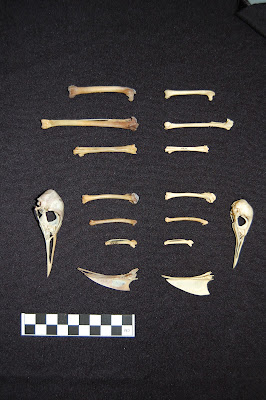Whoops! I thought I had already posted about this so I'm sorry it's late D: This week Dr. Kirchman and I took a hiatus from computer work and did some work in the prep-lab. The prep-lab is where specimens are stuffed and bones are cleaned until they have been perfectly preserved. To get our specimens of choice (bird skeletons) Dr. Kirchman and I got to use the special elevators that went down to the basement to which your average Joe did not have access. In the big freezer (which was kept at a cool 4 degrees Celsius) I came face to face with a badger and a coyote carcass as Dr. Kirchman and I dragged out a plastic box and removed some bird skeletons. We brought the skeletons back to the prep-lab where we donned some gloves and got to work.
First, Dr. Kirchman explained to me how a bird became a skeleton in the lab. I had assumed that some type of liquid dissolved all the tissue on the bird, but I was pretty far off base. It turns out that a type of beetle picks the bones clean, and NYSM has a "bug box" where they put the specimens they want to turn into skeletons. If the temperature is not too cold, the bugs will hop right to work and can turn a bird into a pile of bones in about three days. What we had to do in the prep-lab was take these bones and remove all the bugs that had remained with the bird. The skeletons were placed in the freezer so that the bugs would freeze. Some of the bones were very small, so we had to sift through the bugs with tweezers and pick out the smaller bones. The toe bones were difficult to spot along with the little rings that were sections of the trachea of the bird. Unlike humans, birds' tracheas sometimes ossify which means that the tissue that makes up the trachea is replaced with bone. All the bird bones we sorted were placed in their own jars, each jar corresponding with the size of the bird. I then filled up the jar 80% of the way with water and the rest of the jar with an ammonia solution. In a couple weeks, the skeletons will be ready to go wherever their travels take them.
I had a lot of fun this week besides the smelliness of the bird skeletons and ammonia and got another lesson on keeping careful records in the lab. Each bird skeleton had a metal tag (so the bugs wouldn't eat it) with an identification number on it. The metal tag was taped to the jar the bird skeleton was placed in and there was a corresponding paper card with all the bird's information on it ready to be attached to the skeleton when it is removed from the jar. I am not quite sure what we are doing next week, but it is possibly more computer work as we dive back into the rail project.
